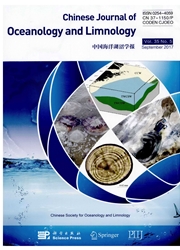

 中文摘要:
中文摘要:
在华东海基于四季节的海洋的调查的数据(23 ° 3 0 ′ - 33 ° N, 118 ° 3 0 ′ - 128 ° E ) 在 1997-2000 期间,作者在区域学习了主导的 Pteropoda 种类的生态的人物。结果证明有五主导的 Pteropodaspecies,更在里面夏天,在秋天并且甚至在另外的季节的更少。这些种类尽管合适,温暖水种类,能在可居住被分成二个不同的组。第一个组在夏天和秋天被适应,包括 Creseis 当第二在冬季和春天组织时, acicula, Desmopterus papilio 和 Creseisvirgule 由 Limacina trochiformis andAgadina syimpsoni 代表了。第一个组比第二个更丰富。而且,第一个组贡献了更多到比第二有更高的出现频率和聚集紧张的 Pteropoda 丰富。在水平分发,第一组织种类居住在近岸,并且他们能在河口附近移居到浅地方并且在高密度聚集,当第二是不同的时:更低的丰富,因为他们是 halophilicwarm 水,少些发生了并且聚集种类,和他们通常充满近海区域。
 英文摘要:
英文摘要:
Based on the data of four seasonal marine surveys in the East China Sea (23°30′-33°N, 118°30′-128°E)during 1997-2000, the author studied the ecological characters of dominant Pteropoda species in the area. Results showed that there were five dominant Pteropoda species, more in summer, less in autumn and even in other seasons. These species, though belonging warm water species, can be categorized into two different groups in habitability. The first group was acicula, Desmopterus papilio and Creseis virgule, while adapted in summer and autumn, including Creseis the second group in winter and spring, represented by Limacina trochiformis and Agadina syimpsoni. The first group was more abundant than the second one. Besides, the first group contributed more to the Pteropoda abundance having higher occurrence frequency and aggregation intensity than the second. In horizontal distribution, the first group species reside in nearshore, and they could migrate to shallow place near estuary and aggregated in high density, while the second one was different: lower abundance, less occurred and aggregated because they were halophilic warm water species, and they were usually abundant in offshore area.
 同期刊论文项目
同期刊论文项目
 同项目期刊论文
同项目期刊论文
 Effect of global warming on the distribution of Lucifer intermedius and L. hanseni (Decapoda) in the
Effect of global warming on the distribution of Lucifer intermedius and L. hanseni (Decapoda) in the 期刊信息
期刊信息
